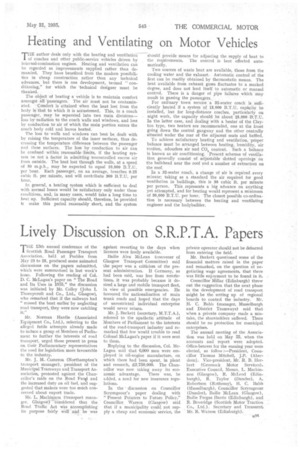Heating and Ventilating on Motor Vehicles
Page 53

If you've noticed an error in this article please click here to report it so we can fix it.
THE author deals only with the heating and ventilation of coaches and other public-service vehicles driven by internal-combustion engines. Heating and ventilation can he regarded as improvements supplied rather than demanded. They have benefited from the modern possibilities in cheap construction rather than any technical advances, but there is one development, termed " conditioning," for which the technical designer must be thanked.
The object of heating' a vehicle is to maintain comfort amongst. all 'passengers. The air must not be contaminated. Comfort is attained when the heat lost from the body is that to which it is accustomed. This, in a coach passenger, may be separated into two main divisions— loss by radiation to the coach walls and windows, and loss by conduction to air of which the main portion enters the coach body cold and leaves heated.
The loss to • walls and windows can best be dealt with by raising the temperature of the inner surfaces, thus decreasing the temperature difference between the passenger and these surfaces. The loss by conduction to air can be confined • within reasonable-limits. if the heating system be not a factor in admitting -uncontrolled excess air from outside. The heat lost through the walls, at a speed of 30 m.p.h., may be expected to equal 10,000 B.T.U. per hour. Each passenger, on an average, breathes 0.25 cubic ft. per minute, and will contribute 300 B.T.U. per hour.
In general, a heating system which is sufficient to deal with normal losses would be satisfactory only under these conditions, and, in many cases, would take a long time to heat up. Sufficient capacity should, therefore, be provided tx make this period reasonably short, and the system should provide means for adjusting the supply of heat to the requirements. The control is best effected automatically.
Two sources of waste heat are available, those from the cooling water and the exhaust. Automatic control of the first can be readily obtained by thermostatic means. The heat available from exhaust gases fluctuates to a marked degree, and does not lend itself to automatic or manual control. There is a danger of pipe failures which may result in gassing the passengers.
For ordinary town service " a 32-seater coach is sufficiently heated if a system of 15,000 B.T.U. capacity be installed, but for long-distance coaches, particularly on night work, the capacity should be about 25,000 ,B.T.U. In the latter case, and dealing with a heater of the Clayton type, two heaters are recommended, one at the front going down the central gangway and the other centrally situated under the rear of the adjacent seats and baffled.
To achieve satisfactory heating and ventilation, proper balance must be arranged between heating, humidity, air motion, odourless air and CO2 content. Such a balance is known as air conditioning. Present schemes of ventilation generally consist of adjustable slotted openings on the bulkhead near the roof and a number of extractors on
the roof. '
In a 32-seater coach, a change of air is required every minute: taking as a standard the air required for good ventilation in buildings, this is 30 cubic ft. per minute per person. This represents a big advance on anything yet attempted, and for heating would represent a minimum of 30,000 B.T.U. per hour. The closest possible co-ordination is necessary between the heating and ventilating engineer and the bodybuilder.




































































































